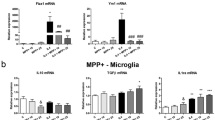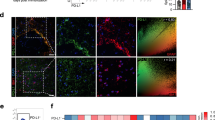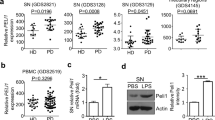Abstract
Chronic neuroinflammation is a common feature of the ageing brain and some neurodegenerative disorders. However, the molecular and cellular mechanisms underlying the regulation of innate immunity in the central nervous system remain elusive. Here we show that the astrocytic dopamine D2 receptor (DRD2) modulates innate immunity through αB-crystallin (CRYAB), which is known to suppress neuroinflammation1,2. We demonstrate that knockout mice lacking Drd2 showed remarkable inflammatory response in multiple central nervous system regions and increased the vulnerability of nigral dopaminergic neurons to neurotoxin 1-methyl-4-phenyl-1,2,3,6-tetrahydropyridine (MPTP)-induced neurotoxicity3. Astrocytes null for Drd2 became hyper-responsive to immune stimuli with a marked reduction in the level of CRYAB. Preferential ablation of Drd2 in astrocytes robustly activated astrocytes in the substantia nigra. Gain- or loss-of-function studies showed that CRYAB is critical for DRD2-mediated modulation of innate immune response in astrocytes. Furthermore, treatment of wild-type mice with the selective DRD2 agonist quinpirole increased resistance of the nigral dopaminergic neurons to MPTP through partial suppression of inflammation. Our study indicates that astrocytic DRD2 activation normally suppresses neuroinflammation in the central nervous system through a CRYAB-dependent mechanism, and provides a new strategy for targeting the astrocyte-mediated innate immune response in the central nervous system during ageing and disease.
This is a preview of subscription content, access via your institution
Access options
Subscribe to this journal
Receive 51 print issues and online access
$199.00 per year
only $3.90 per issue
Buy this article
- Purchase on Springer Link
- Instant access to full article PDF
Prices may be subject to local taxes which are calculated during checkout




Similar content being viewed by others
References
Bhat, R. & Steinman, L. Innate and adaptive autoimmunity directed to the central nervous system. Neuron 64, 123–132 (2009)
Ousman, S. S. et al. Protective and therapeutic role for αB-crystallin in autoimmune demyelination. Nature 448, 474–479 (2007)
Langston, J. W., Ballard, P., Tetrud, J. W. & Irwin, I. Chronic Parkinsonism in humans due to a product of meperidine-analog synthesis. Science 219, 979–980 (1983)
Lucin, K. M. & Wyss-Coray, T. Immune activation in brain aging and neurodegeneration: too much or too little? Neuron 64, 110–122 (2009)
Seeman, P. et al. Human brain dopamine receptors in children and aging adults. Synapse 1, 399–404 (1987)
Kaasinen, V. et al. Age-related dopamine D2/D3 receptor loss in extrastriatal regions of the human brain. Neurobiol. Aging 21, 683–688 (2000)
Antonini, A. & Leenders, K. L. Dopamine D2 receptors in normal human brain: effect of age measured by positron emission tomography (PET) and [11C]-raclopride. Ann. NY Acad. Sci. 695, 81–85 (1993)
Zhang, Y. & Barres, B. A. Astrocyte heterogeneity: an underappreciated topic in neurobiology. Curr. Opin. Neurobiol. 20, 588–594 (2010)
Bal, A. et al. Evidence for D2 receptor mRNA expression by striatal astrocytes in culture: in situ hybridization and polymerase chain reaction studies. Brain Res. Mol. Brain Res. 23, 204–212 (1994)
Luo, X., Zhang, X., Shao, W., Yin, Y. & Zhou, J. Crucial roles of MZF-1 in the transcriptional regulation of apomorphine-induced modulation of FGF-2 expression in astrocytic cultures. J. Neurochem. 108, 952–961 (2009)
Saijo, K. et al. A Nurr1/CoREST pathway in microglia and astrocytes protects dopaminergic neurons from inflammation-induced death. Cell 137, 47–59 (2009)
Zhuo, L. et al. hGFAP-cre transgenic mice for manipulation of glial and neuronal function in vivo . Genesis 31, 85–94 (2001)
Iwaki, T., Kume-Iwaki, A., Liem, R. K. & Goldman, J. E. αB-crystallin is expressed in non-lenticular tissues and accumulates in Alexander’s disease brain. Cell 57, 71–78 (1989)
Hagemann, T. L., Boelens, W. C., Wawrousek, E. F. & Messing, A. Suppression of GFAP toxicity by αB-crystallin in mouse models of Alexander disease. Hum. Mol. Genet. 18, 1190–1199 (2009)
Jackson-Lewis, V. & Przedborski, S. Protocol for the MPTP mouse model of Parkinson’s disease. Nature Protocols 2, 141–151 (2007)
Rivest, S. Regulation of innate immune responses in the brain. Nature Rev. Immunol. 9, 429–439 (2009)
Saijo, K., Collier, J. G., Li, A. C., Katzenellenbogen, J. A. & Glass, C. K. An ADIOL-ERβ-CtBP transrepression pathway negatively regulates microglia-mediated inflammation. Cell 145, 584–595 (2011)
Saijo, K., Crotti, A. & Glass, C. K. Nuclear receptors, inflammation, and neurodegenerative diseases. Adv. Immunol. 106, 21–59 (2010)
Brady, J. P. et al. αB-crystallin in lens development and muscle integrity: a gene knockout approach. Invest. Ophthalmol. Vis. Sci. 42, 2924–2934 (2001)
Xu, M. et al. Dopamine D3 receptor mutant mice exhibit increased behavioral sensitivity to concurrent stimulation of D1 and D2 receptors. Neuron 19, 837–848 (1997)
Casper, K. B., Jones, K. & McCarthy, K. D. Characterization of astrocyte-specific conditional knockouts. Genesis 45, 292–299 (2007)
Cai, L. et al. Ethanol-induced neurodegeneration in NRSF/REST neuronal conditional knockout mice. Neuroscience 181, 196–205 (2011)
Kelly, M. A. et al. Pituitary lactotroph hyperplasia and chronic hyperprolactinemia in dopamine D2 receptor-deficient mice. Neuron 19, 103–113 (1997)
Drago, J. et al. Altered striatal function in a mutant mouse lacking D1A dopamine receptors. Proc. Natl Acad. Sci. USA 91, 12564–12568 (1994)
Ousman, S. S. et al. Protective and therapeutic role for αB-crystallin in autoimmune demyelination. Nature 448, 474–479 (2007)
Li, A. et al. Apomorphine-induced activation of dopamine receptors modulates FGF-2 expression in astrocytic cultures and promotes survival of dopaminergic neurons. FASEB J. 20, 1263–1265 (2006)
Sauer, H., Rosenblad, C. & Bjorklund, A. Glial cell line-derived neurotrophic factor but not transforming growth factor beta 3 prevents delayed degeneration of nigral dopaminergic neurons following striatal 6-hydroxydopamine lesion. Proc. Natl Acad. Sci. USA 92, 8935–8939 (1995)
Menet, V. et al. Inactivation of the glial fibrillary acidic protein gene, but not that of vimentin, improves neuronal survival and neurite growth by modifying adhesion molecule expression. J. Neurosci. 21, 6147–6158 (2001)
Saura, J., Tusell, J. M. & Serratosa, J. High-yield isolation of murine microglia by mild trypsinization. Glia 44, 183–189 (2003)
Guo, H. et al. Apomorphine induces trophic factors that support fetal rat mesencephalic dopaminergic neurons in cultures. Eur. J. Neurosci. 16, 1861–1870 (2002)
Zhou, Q., Li, J., Wang, H., Yin, Y. & Zhou, J. Identification of nigral dopaminergic neuron-enriched genes in adult rats. Neurobiol. Aging 32, 313–326 (2011)
Dimberg, A. et al. αB-crystallin promotes tumor angiogenesis by increasing vascular survival during tube morphogenesis. Blood 111, 2015–2023 (2008)
Sauer, H. & Oertel, W. H. Progressive degeneration of nigrostriatal dopamine neurons following intrastriatal terminal lesions with 6-hydroxydopamine: A combined retrograde tracing and immunocytochemical study in the rat. Neuroscience 59, 401–415 (1994)
Acknowledgements
We thank B. Zhang and Y. J. Yan for technical assistance; L. Zhu for technical support in DNA microarray analysis; the Optical Imaging Center of ION and the Cell Biology Analysis Center of IBCB for technical support in confocal microscopy; T. L. Hagemann for providing the CRYAB construct; R. Quinlan for anti-CRYAB antibodies, Y. Q. Ding for providing the Drd1 and Drd2 gene null mice; we also thank Shanghai Research Center for Model Organisms for creating Drd2-floxed mice. This work was supported by grants from the Chinese Academy of Sciences, National Basic Research Program of China (nos 2011CBA00408 and 2011CB504102), Natural Science Foundation of China (nos 31021063 and 31123002), and Shanghai Metropolitan Fund for Research and Development.
Author information
Authors and Affiliations
Contributions
W.S., S.-z.Z. conducted most of the in vivo and in vitro experiments and the data analysis, M.T., Z.Z. prepared cell cultures, Y.-q.Y. and Y.-j.L. contributed to cell cultures; X.-h.Z. and Q.-b.Z. contributed to pilot experiments. Y.-q.Y. and Y.-y.H. contributed to genotyping; E.W. provided CRYAB mutant mice; T.C, S.-b.L. and M.X. provided Drd3 mutant mice; J.-n.Z., G.H. provided pathological samples and/or advice and J.-w.Z. supervised the project and wrote the manuscript.
Corresponding author
Ethics declarations
Competing interests
The authors declare no competing financial interests.
Supplementary information
Supplementary Figures
This file contains Supplementary Figures 1-19. (PDF 2476 kb)
Supplementary Data
This file contains Supplementary Table 1. (XLS 164 kb)
Rights and permissions
About this article
Cite this article
Shao, W., Zhang, Sz., Tang, M. et al. Suppression of neuroinflammation by astrocytic dopamine D2 receptors via αB-crystallin. Nature 494, 90–94 (2013). https://doi.org/10.1038/nature11748
Received:
Accepted:
Published:
Issue Date:
DOI: https://doi.org/10.1038/nature11748
This article is cited by
-
Dopamine enhances recovery after traumatic brain injury through ubiquitylation and autophagic degradation of RIPK1
Cell Communication and Signaling (2024)
-
Farrerol Alleviates Cerebral Ischemia–Reperfusion Injury by Promoting Neuronal Survival and Reducing Neuroinflammation
Molecular Neurobiology (2024)
-
Can NogoA Be a Suitable Target to Treat Ischemic Stroke?
Neuroscience Bulletin (2024)
-
Dopamine D2 receptor on CD4+ T cells is protective against inflammatory responses and signs in a mouse model of rheumatoid arthritis
Arthritis Research & Therapy (2023)
-
RGS5 augments astrocyte activation and facilitates neuroinflammation via TNF signaling
Journal of Neuroinflammation (2023)
Comments
By submitting a comment you agree to abide by our Terms and Community Guidelines. If you find something abusive or that does not comply with our terms or guidelines please flag it as inappropriate.



